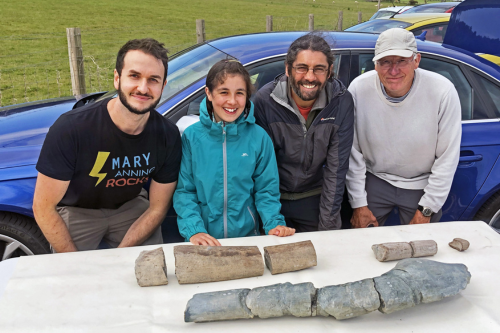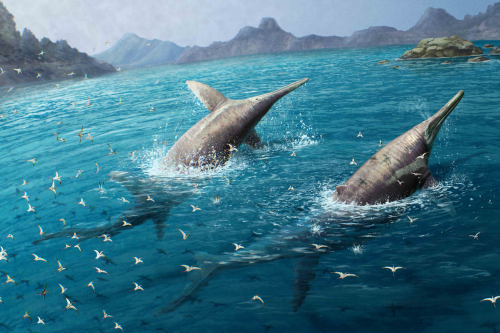Experts have identified the bones as belonging to the jaws of a new species of enormous ichthyosaur, a type of prehistoric marine reptile. Estimates suggest the oceanic titan would have been more than 25 metres long.
Father and daughter team, Justin and Ruby Reynolds from Braunton, Devon, found the first pieces of the second jawbone in May 2020, whilst searching for fossils on the beach at Blue Anchor, Somerset. Ruby, then aged 11, found the first chunk of giant bone. Together, they searched the area and found additional pieces.
Realising they had discovered something significant, they contacted leading ichthyosaur expert, Dr Dean Lomax, an 1851 Research Fellow at the University of Bristol. Thrilled by this discovery, Dr Lomax, who is also a palaeontologist at the University of Manchester, contacted Paul de la Salle, a seasoned fossil collector who had found the first giant jawbone in May 2016 from further along the coast at Lilstock.
Dr Dean Lomax said: “I was amazed by the find. In 2018, my team (including Paul de la Salle) studied and described Paul’s giant jawbone and we had hoped that one day another would come to light. This new specimen is more complete, better preserved, and shows that we now have two of these giant bones (called a surangular) that have a unique shape and structure. I became very excited, to say the least.”
Justin and Ruby, together with Paul, Dr Lomax, and several family members, visited the site to hunt for more pieces of this rare discovery. In time, the team found additional pieces of the same jaw which fit together perfectly, like a multimillion-year-old jigsaw.
Justin commented: “When Ruby and I found the first two pieces we were very excited as we realised that this was something important and unusual. When I found the back part of the jaw, I was thrilled because that is one of the defining parts of Paul's earlier discovery.” The last piece of bone was recovered in October 2022.
The research team, led by Dr Lomax, revealed that the jaw bones belong to a new species of giant ichthyosaur that would have been about the size of a blue whale. Having two examples of the same bone with the same unique features from the same geologic time zone supports their identifications. The team have called the new genus and species Ichthyotitan severnensis, meaning “giant fish lizard of the Severn.”
The bones are around 202 million years old, dating to the end of the Triassic Period in a time known as the Rhaetian. During this time, the gigantic ichthyosaurs swam the seas while the dinosaurs walked on land. It was the titans’ final chapter, however—as the story told in the rocks above these fossils record a cataclysm known as the Late Triassic global mass extinction event. After this time, giant ichthyosaurs from the family known as Shastasauridae go extinct.
Today, these bones represent the very last of their kind. Ichthyotitan is not the world’s first giant ichthyosaur, but de la Salles’ and Reynolds’ discoveries are unique among those known to science. These two bones appear roughly 13 million years after their latest geologic relatives, including Shonisaurus sikanniensis from British Columbia, Canada, and Himalayasaurus tibetensis from Tibet, China.
Commenting on the research, Dr Lomax added: “I was highly impressed that Ruby and Justin correctly identified the discovery as another enormous jawbone from an ichthyosaur. They recognised that it matched the one we described in 2018. I asked them whether they would like to join my team to study and describe this fossil, including naming it. They jumped at the chance. For Ruby, especially, she is now a published scientist who not only found but also helped to name a type of gigantic prehistoric reptile. There are probably not many 15-year-olds who can say that! A Mary Anning in the making, perhaps.”
When asked about her find and involvement with the study, Ruby said: “It was so cool to discover part of this gigantic ichthyosaur. I am very proud to have played a part in a scientific discovery like this.”
Part of the research also focused on providing supporting evidence that these bones are indeed from the jaws of giant ichthyosaurs.
Team member and master’s student, Marcello Perillo, from the University of Bonn, Germany, took core samples of the new bones, along with others, to examine the internal structures. His work confirmed the ichthyosaur origin of the bones and revealed that the animal was still growing at the time of death.
“We could confirm the unique set of histological characters typical of giant ichthyosaur lower jaws: the anomalous periosteal growth of these bones hints at yet to be understood bone developmental strategies, now lost in the deep time, that likely allowed late Triassic ichthyosaurs to reach the known biological limits of vertebrates in terms of size. So much about these giants is still shrouded by mystery, but one fossil at a time we will be able to unravel their secrets,” added Perillo.
Jimmy Waldron, research team member and founder of the DWABA museum in Orlando, Florida said: “Every fossil fan dreams of an experience like Ruby’s – and she deserves all the joy and excitement. To be the first human eyes to look upon this incredible fossil after 202 million years is truly special. Justin is setting a grand example by supporting his daughter’s interests in science and palaeontology. Fossils like Ichthyotitan offer glimpses into unknown chapters of life on Earth, and it’s our responsibility to share these wonders and the processes with the public." Waldron is creating scaled 3D replicas of the giant bones for displays and outreach programmes around the world.
Concluding the work, Paul de la Salle added: “To think that my discovery in 2016 would spark so much interest in these enormous creatures fills me with joy. When I found the first jawbone, I knew it was something special. To have a second that confirms our findings is incredible. I am overjoyed.”
The new research has been published today in the open access journal PLOS ONE, the same journal that published the first study in 2018. Ruby, Justin and Paul’s discoveries will soon go on display at the Bristol Museum and Art Gallery.
Dr Lomax explained: “This research has been ongoing for almost eight years. It is quite remarkable to think that gigantic, blue whale-sized ichthyosaurs were swimming in the oceans around what was the UK during the Triassic Period. These jawbones provide tantalising evidence that perhaps one day a complete skull or skeleton of one of these giants might be found. You never know.”


